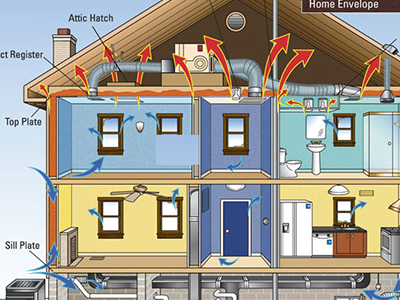Indoor Airflow & Pollutant Transport
Indoor Airflow & Pollutant Transport
Our group uses whole-building airflow models, particularly box models and multizone models, to measure, analyze and predict airflow and the transport of pollutants in buildings. We run the models to understand specific scenarios that might occur, and create the scientific foundation for safe, efficient and resilient building operations.
 Impact on Energy Efficiency
Impact on Energy Efficiency
The SES group uses whole-building airflow models to predict airflow and pollutant transport in buildings.
Airflow directly affects the energy used by a building.
For example, when air from outside needs to be conditioned to a comfortable temperature and humidity, that directly relates to energy use. Airflow also transports pollutants. The resulting pollutant concentrations have health implications, such as when combustion products from a furnace or water heater enter the living spaces.
Type of Building Airflow and Pollutant Transport Models
- Box models, which represent an entire building as a single well-mixed space.
- Multizone models, which can capture details between, but not within, rooms.
- Computational fluid dynamic (CFD) models, which analyze a room on a much finer scale.
We primarily work with box models and multizone models. We write code to implement these models. We also run those models to understand specific scenarios that may occur, including predicting the health impacts of indoor and outdoor pollutant releases, and to evaluate model uncertainty. Finally, we use these models to help make decisions, including:
- Choosing the best sampler locations to detect accidental releases of pollutant.
- Inferring the strength and location of a source based on sensor data.
- Recommending "shelter-in-place" strategies.
- Helping to advance the modeling of airflows in whole-building energy simulation tools, such as EnergyPlus.

